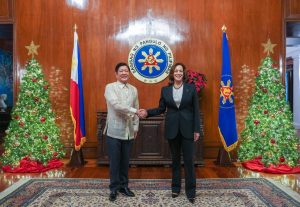The U.S. security commitment to the Philippines remains “unwavering,” U.S. Vice President Kamala Harris said yesterday in Manila, announcing a range of new initiatives designed to expand and deepen the longstanding security alliance after a troubled six years under President Rodrigo Duterte.
Meeting with President Ferdinand Marcos Jr. at the Presidential Palace on the first day of her three-day visit to the country, she reiterated Washington’s commitment to defend the Philippines under the two nations’ 1951 Mutual Defense Treaty.
“We stand with you in defense of international rules and norms as it relates to the South China Sea,” Harris told Marcos at the presidential palace in Manila, according to The Associated Press. “An armed attack on the Philippines armed forces, public vessels, or aircraft in the South China Sea would invoke U.S. Mutual Defense commitments.”
The extension of the U.S. treaty commitments to the Philippine-claimed regions of the South China Sea, which was only formally incorporated by Manila in 1978, repeats an assurance made by the Trump administration in 2019. In response, Marcos thanked Harris, saying that the U.S.-Philippine alliance was “even more important” given the context of growing strategic tensions in the region and beyond.
Today, Harris will also become the highest-ranking U.S. official to visit Palawan, the Philippines’ westernmost island, which lies adjacent to the disputed Spratly Islands, where she is set to underscore the U.S. commitment “to stand up for the international rules and norms.”
The vice president’s visit comes just days after China’s coast guard “forcefully” seized Chinese rocket debris that Filipino navy personnel had found floating off the shore of Philippine-occupied Thitu Island and attempted to tow back to the island. Thitu, the primary Philippine settlement in the disputed part of the South China Sea, lies around 500 kilometers off the coast of Palawan.
Harris’s visit also confirmed earlier reports that the U.S. will spend $66.5 million expanding its military presence in the Philippines under the Enhanced Defense Cooperation Agreement (EDCA). The pact, which allows U.S. troops to use five locations in the Philippines for security exercises and joint military training on a rotational basis, was signed in 2014 following a period of unusual China-Philippine tensions in the South China Sea, but largely lapsed under President Rodrigo Duterte, who spurned the U.S. alliance during his six-year term.
A senior Biden administration official said in a media briefing yesterday that the revival of EDCA will “allow for more security cooperation exercises, combined training activities, and it will allow us to respond to disaster relief and humanitarian assistance needs,” according to the U.S.-funded broadcaster Voice of America. The official confirmed earlier reports that the U.S. is seeking access to five additional EDCA sites but declined to provide details on those locations.
Most significant, perhaps, was the range of non-security-related U.S. initiatives announced by Harris and her delegation. This included assistance to help the Philippines deal with climate change and looming food and energy crises, an agreement on critical mineral supply chains, and a geothermal power project on the southern island of Mindanao.
It also included talks on a proposed agreement that would provide the legal basis for U.S. exports of nuclear equipment and material for energy to the Philippines. Under Marcos’ father, the dictator Ferdinand E. Marcos, the Philippines took the first steps toward developing a civilian nuclear energy capacity, but the program lapsed following the Chernobyl nuclear disaster and Marcos’ ouster amid mass protests in 1986.
This assistance sends the message that a close relationship with the U.S. is not just about fighter jets and aircraft carriers, but also responds in a meaningful way to the development needs of partners and allies. Whether Washington can extend such an approach to the rest of Southeast Asia, where its economic engagement has lagged far behind its security commitments, remains to be seen. But taken as a whole, Harris’ visit can be marking a definitive end of the Duterte era, which saw the U.S. alliance stagnate amid the president’s anti-Americanism, constant policy reversals, and volatile shifts.
Harris’ visit took place concurrently with a trip by U.S. Defense Secretary Lloyd J. Austin to Indonesia, another strategically important archipelagic nation where the U.S. is seeking to expand its security presence.
Speaking at a joint news press conference with Indonesian Defense Minister Prabowo Subianto, Austin said they discussed ways to deepen the two countries’ partnership, including through expanding interoperability and increasing investments in defense education. “The United States is proud to partner with you as we work together to advance our shared vision of a free and open Indo-Pacific,” Austin said, the AP reported.
However, the reception was several steps less exuberant than that which greeted Harris in Manila, with Prabowo reminding Austin that Indonesia would continue to hew to a non-aligned position amid the growing Sino-American competition. “I like to emphasize that Indonesia always takes the position of trying to maintain the best relationships with all nations, especially all the major powers,” he said.

































